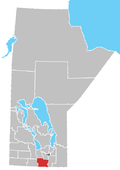Sperling | |
|---|---|
 Grain Elevator at Sperling (Demolished 2015) | |
Location of Sperling in Manitoba | |
| Coordinates: 49°30′29″N97°42′17″W / 49.50806°N 97.70472°W | |
| Country | |
| Province | |
| Region | Pembina Valley |
| Census Division | No. 3 |
| Government | |
| • Governing Body | Rural Municipality of Morris Council |
| • MP | Candice Hoeppner |
| • MLA | Lauren Stone |
| Time zone | UTC−6 (CST) |
| • Summer (DST) | UTC−5 (CDT) |
| Postal Code | R0G 2M0 |
| Area code | 204 |
| NTS Map | 062H12 |
| GNBC Code | GBACH |
Sperling is an unincorporated community in south central Manitoba, Canada. It is located on Provincial Trunk Highway 3 approximately 56 kilometers (36 miles) southwest of Winnipeg, Manitoba [1] in the Rural Municipality of Morris.

